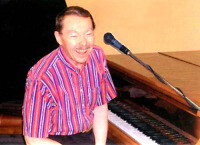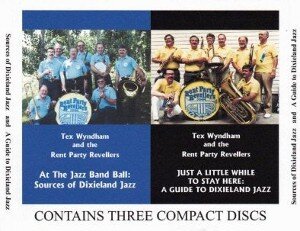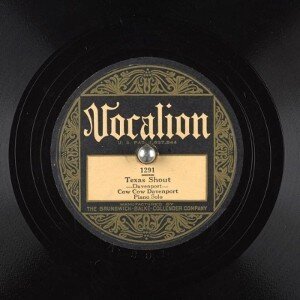 Set forth below is the fiftieth “Texas Shout” column. The initial installment of a two-part essay, it first appeared in the May 1994 issue of West Coast Rag, now known as The Syncopated Times.
Set forth below is the fiftieth “Texas Shout” column. The initial installment of a two-part essay, it first appeared in the May 1994 issue of West Coast Rag, now known as The Syncopated Times.
The text has not been updated. I have tacitly deleted material consisting essentially of a review of a then-new religiously oriented jazz recording, believing that reprinting a discussion of a record released years ago, which may no longer be in print, serves no useful purpose. Also, I no longer write for Coda, having retired from jazz writing (except for liner note assignments) in early 1998.
In the mid-1960s, though I had loved ragtime for about a dozen years, I had practically nothing to show for it. I had yet to meet another ragtimer. There was virtually no published ragtime music on the market. I bought all the ragtime LPs I could find, but they comprised a mighty slim shelf.
One day, while thumbing a magazine at a newsstand (I think it was High Fidelity), I saw a review of an LP of ragtime piano solos by Tom Shea, a name I didn’t then know. Anything that smacked of ragtime was good enough for me, so I bought the periodical and ordered the album. The seller was listed as The Ragtime Society, with an address in Toronto.
When the disc arrived, it was accompanied by material describing the Society. The group had not only produced this record, but also published a periodical about ragtime and even reprinted some of the old sheet music. I joined right away, while ordering back issues of the newsletter plus all available Society products.
I was delighted to discover an organization doing something to support this nearly forgotten music that I enjoyed so much. I would have been happy to help out, but there didn’t seem to be much I could do at a distance.
Shortly thereafter, the great ragtime and barrelhouse pianist Knocky Parker recorded four LPs of vintage rags, most of which were otherwise unavailable on vinyl. When I got my copies, I was surprised to find that, in two respects, they differed from what I had expected.
First, probably to get more titles on each platter, Parker usually omitted repeats. Well, I could live with that aspect of the set.
Second, probably to get variety into the show, the performances were spliced between strains. For example, the first strain might be on piano accompanied by string bass, the second on harpsichord accompanied by tuba, the third on celeste accompanied by banjo, etc.
I found this practice distracting and thought others might also.
I painstakingly listened through the four recordings, noting which rags were played by which combinations. The results were edited into a record review which I sent to The Ragtime Society, knowing that many society members would unhesitatingly buy the set on the strength of Parker’s reputation and wanting them to know what to expect. The review was published in the November 1966 edition of the Society’s newsletter.
At that point , I realized that I had about as comprehensive a collection of U.S.-produced ragtime LPs as was available. I figured I could help out the Society by keeping it apprised of new releases.
So, each time I acquired a new ragtime record, I wrote up a review and sent it north of the border, becoming the Society’s regular reviewer. My wife and I then began attending the Society’s annual Bash, at which John Norris, publisher of Coda (Canada’s leading jazz magazine) maintained the record bar. We got to know John and his second in command, Bill Smith, on these trips, both at the Bash and via visiting the record shop they operated. John soon asked me if I would write record reviews for Coda.
I had subscribed to Coda some years previously and had let it lapse because its focus was too much on modern jazz for my taste. I explained my position to John, who told me that they really wanted to cover all jazz styles, would give me the records along with a free subscription, and had been planning to add a knowledgeable writer on older-style jazz to the staff. On that basis, I agreed (and have been a Coda writer ever since).
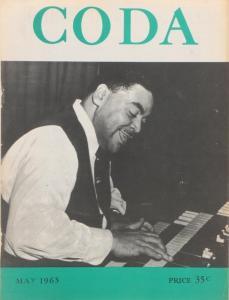 Soon artists and producers began giving me records to review. Needing an outlet for the reviews, I wound up writing for a small older-style jazz magazine called Jazz Digest.
Soon artists and producers began giving me records to review. Needing an outlet for the reviews, I wound up writing for a small older-style jazz magazine called Jazz Digest.
That periodical eventually ceased publication. In the meantime, I had done a few concert and festival reviews for The Mississippi Rag. Thus, I became an MR reviewer in 1978.
For the next dozen years, I estimate that I wrote about 40% of MR‘s record reviews, plus some commentaries on festivals, books, and music folios. Shortly after “Texas Shout” was inaugurated for West Coast Rag in 1989, my record reviews moved to WCR as well, in a column entitled “This Month’s Records” (TMR).
Except for Coda, which still sends me the records it wants me to review, I rarely review records sent to a publication. I have all I can do to stay even with the ones sent directly to my home. I haven’t made an official count, but I’d guess that, since the first one in November 1966, I’ve had more published reviews (many hundreds) of recordings of ragtime, Dixieland and closely related music than any other U.S.-based writer.
Wanting to give the musicians the fairest possible shake, I confine my reviews to music in which I have a special interest. If I receive an album which, on a cursory listen, falls outside that area (typically, it’ll be a modern jazz recording), I’ll note its availability in TMR, but will not comment on it qualitatively or assign it a ranking in my one-to-five star system.
Some recordings pose difficult questions as to whether or not they should be reviewed in a column essentially for fans of Dixieland and ragtime. For example, an item may have some tracks within the scope of TMR, but others outside it. Or, an artist whose main activity and reputation has been in Dixieland and ragtime may come up with an album consisting partially or primarily of other types of music.
Nevertheless, if I review an album in TMR, I assume that the readership wants to know where it stands judged as a Dixieland or ragtime record. If it isn’t all that jazzy (or raggy), whatever its other merits may be, it won’t get a five-star rating from me.
For example, suppose the South Frisco Jazz Band issues a CD of grand opera, with Vince singing arias from “Don Giovanni” and Bob’s tuba reproducing the basso solos. South Frisco fans may well flock to it as a change-up from SFJB’s usual raunchy post-Watters two-beat, and it may get a standing ovation at the Met, but it is unlikely to get many stars in TMR.
I would have thought these principles were well enough understood by my readers to go without saying. However, some time back I received a review copy of an album from a friend of mine, a fine musician who leads a well-known, highly regarded band on the festival circuit. The recording consisted of tunes with a generally religious/spiritual orientation, played in Dixieland style but with more restraint than on the combo’s previous releases.
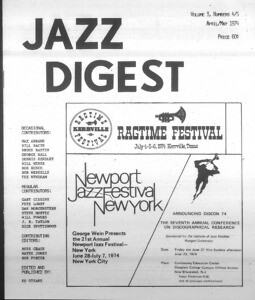 After describing the album’s several worthwhile points, I felt obligated to say that it was tamer than usual. This assessment, as indicated above, resulted in a below-average overall rating on my five-star scale.
After describing the album’s several worthwhile points, I felt obligated to say that it was tamer than usual. This assessment, as indicated above, resulted in a below-average overall rating on my five-star scale.
A few issues later, the letters column included a note from my friend in which he agreed with my opinion that the recording was not as hot as usual. However, he seemed somewhat put out with me for saying so, stating that I had missed the point of the album.
Perhaps I did, and if so, I regret the error. I do try hard not to criticize artists for failing to do something that they aren’t trying to do in the first place.
On the other hand, I believe that TMR readers are essentially looking for information that will lead them to superior recordings of ragtime and hot Dixieland jazz. I don’t want to mislead anyone into spending money for something that doesn’t rank high by that standard, regardless of how good it is in other ways.
These remarks stem from two sources. First, in discussing possible topics for “Texas Shout” with WCR‘s editor, Woody thought you might be interested in hearing how I found my way into record reviewing. Second, I have received another religiously oriented album by a famous Dixieland band.
I have now encountered two religious albums by respected Dixieland units that, on the whole, contain less hot jazz than those bands’ established norms. Perhaps that fact explains something I’ve wondered about recently.
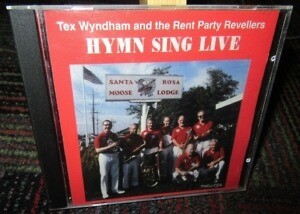 When The Rent Party Revellers were asked to work up a Sunday morning show for the 1989 Shasta festival, I had not yet seen one by another jazz band. I assumed that, because the show would be a regularly scheduled Revellers set at the festival, the audience was entitled to a full measure of hot jazz.
When The Rent Party Revellers were asked to work up a Sunday morning show for the 1989 Shasta festival, I had not yet seen one by another jazz band. I assumed that, because the show would be a regularly scheduled Revellers set at the festival, the audience was entitled to a full measure of hot jazz.
Thus, I picked a program of tunes that would fit in with the uplifting nature of the occasion, but ones with a wide-open construction to allow us ample room for hard-driving rent party Dixieland. Believe me, we did not pull any punches in performing them.
Our show proved popular and was repeated at other festivals, at which we started to get requests for recordings thereof. Dan Jazz Productions waxed it as performed at the 1992 Santa Rosa festival. The album has sold very well whenever we present our “Hymn Sing.”
Conversely, if we are not doing the show, Nancy tells me that fans who approach our record table looking for Revellers albums sometimes pass “Hymn Sing Live!” with hardly a glance, telling her that they don’t like such recordings. I wondered why they felt that way, but now I think that these folks have been conditioned by other combos to expect that religiously oriented Dixieland records aren’t going to be as jazzy as usual. Well, you live and learn.
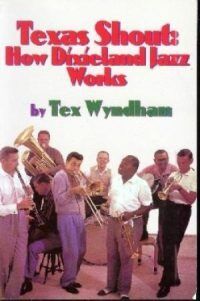 Want to read ahead? Buy the book!
Want to read ahead? Buy the book!
The full run of “Texas Shout” has been collected into a lavishly illustrated trade paperback entitled Texas Shout: How Dixieland Jazz Works. This book is available @ $20.00 plus $2.95 shipping from Tex Wyndham, On request, Tex will autograph the book and add a personalized note (be sure to tell him to whom the note should be addressed).
Tex Wyndham’s 3 CD Guide to Dixieland with music and commentary is available for $20 plus $2.95 shipping. The separate CD, A History of Ragtime: Tex Wyndham Live At Santa Rosa, is available for $13.00 plus $2.00 shipping. On request, Tex will autograph the inner sleeve and add a personalized note (be sure to tell him to whom the note should be addressed).
Send payment to Tex Wyndham, P.O. Box 831, Mendenhall, PA 19357, Phone (610) 388-6330.
Note: All links, pictures, videos or graphics accompanying the Shouts were added at the discretion of the Syncopated Times editorial staff. They did not accompany the original columns and do not necessarily reflect the opinion of Tex Wyndham.
From roughly 1970-2010, Tex Wyndham was: (1) one of the best-known revivalist Dixieland jazz musicians in the US, as cornetist, pianist and bandleader, (2) one of the best-known ragtime pianists in the US, and (3) one of the most respected critics in the US of Dixieland jazz, ragtime, and related music. He is the only person about whom all three of those statements can be made.

